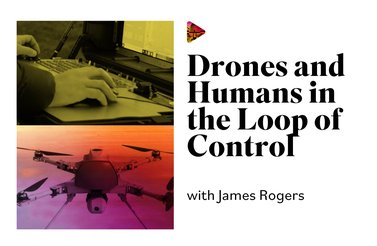on-state drone strikes persisted at a pace in the opening months of 2022 as the Iranian government continued to “vow revenge” for the assassination of General Qasem Soleimani two years before. History will regard that day in 2020 — January 3, to be precise — as a watershed moment in twenty-first-century conflict. Not only did the strike mark the first killing of a state official by drone strike in a third-party nation without that nation’s permission, but it also symbolized the extraordinary value that the administration of then US President Donald Trump placed on Soleimani’s power to control an array of non-state proxies — reportedly supplied with Iranian military drone technologies — who acted in Iran’s interests (UN Human Rights Council 2020). Indeed, this lethal drone strike arguably galvanized those same proxies, who began to conduct increasingly daring drone attacks against US and allied targets throughout 2022. It was on the exact day marking the second anniversary of Soleimani’s death that two armed drones, emblazoned with the words “Soleimani’s revenge,” were shot down as they targeted US troops based near Baghdad International Airport (Hauptman 2022). On January 17, 2022, Iranian-backed Houthi rebels fired drones and missiles at key transport and industrial sites in Abu Dhabi. These lethal attacks killed three people and damaged a new extension of the city’s international airport (Mallo et al. 2022). Put into context, the strikes marked the start of a week of drone, rocket and missile strikes on both US and allied military sites and key strategic targets within the United Arab Emirates (UAE) and across the Middle East (Turak 2022). The escalation of Russia’s offensive war against Ukraine in February 2022 shifted public, policy and press attention away from such precision strikes in the Middle East. Nevertheless, attacks continued apace, with a “new normal” emerging in terms of threats faced. Indeed, each attack during 2022 has acted as a pertinent reminder of what happens when state-manufactured advanced weapons technologies fall — or are perhaps placed — into the hands of hostile non-state organizations.
As we look to the future of non-state drone use, and the so-called Third Drone Age, it is these contemporary examples of weapons technology transfer from nation-state to non-state actors, that can help us to understand how next-generation technologies may also slip into the hands of terroristic or militant groups. Specifically, this essay will build on three strategic foresight analysis workshops on future drone warfare. These were organized by the author and Dominika Kunertova,1 funded by the North Atlantic Treaty Organization’s (NATO’s) Science for Peace and Security (SPS) program and held in 2021. The essay also builds on and the author’s primary interviews with Iraqi military officials, Kurdish forces, human rights experts, regional and international journalists, and policy makers and military personnel from the UAE and the United States who have faced increasing hostile drone threats since 2016. Finally, it will also build on the author’s fieldwork in the Middle East and Sahel tracking the proliferation of weaponized drone technologies to non-state actors. In essence, the essay adopts a strategic foresight analysis methodology, drawing on primary and secondary sources to envision elements of the Third Drone Age out to 2040. This includes, but is not limited to, analysis on the likelihood that autonomous, swarming and full-spectrum air, land and sea drones (with increasing levels of long-distance precision strike) will proliferate beyond the control of nation-states and into the hands of non-state actors by 2040.
What Is the Third Drone Age?
To understand the Third Drone Age, we need to understand where drone warfare has come from and where it is going in terms of the evolution of precision strike technologies and state/non-state drone deployments. The First Drone Age was defined by the post-September 11 world and driven by the demands of Western states to meet the threat of global terrorism. In this context, armed medium-altitude long-endurance (MALE) drones — such as the Predator — were deployed as a means to hunt and kill those defined as terrorists, while reducing the number of boots on the ground. During the administration of George W. Bush, and exponentially so during the Barack Obama era, the drone was seen as a panacea to the costs and risks of modern warfare, allowing the United States and select state allies to target terrorists around the world at a reduced risk to military personnel (Rogers 2018). “Asymmetric warfare,” as it was known, meant that powerful Western forces, epitomized by high-tech armed military drones and precision missiles, faced weaker groups with disparate military capabilities (and certainly not armed drones). In this environment of the “drone haves and have nots,” the United States and its allies achieved command of the air, dominating the airspace over regions of active and undeclared conflict. This is not to say that these less powerful groups were ineffective, but rather that airpower was the preserve of the world’s more powerful states. Indeed, a key characteristic of asymmetric warfare is that “the weaker party, recognizing the military superiority of its opponent, will avoid open confrontation that is bound to lead to annihilation….Instead, it will compensate its inadequate arsenal by employing unconventional means and methods” (Pfanner 2005, 153). The improvised explosive device (IED) was part of this unconventional asymmetric effort, making the ground upon which Western troops set foot an unpredictable minefield. By reducing Western infantry to a snail’s pace and applying significant pressure on limited counter-IED expertise, coalition forces were heavily affected in terms of both military effectiveness and spiralling casualties. To put this into perspective, up to 50 percent of all casualties in Iraq and Afghanistan were caused by the IED (Overton 2020). “Remote warfare,” it has been argued, arose as an alternative to this cost-heavy form of Western interventions. Although perhaps more accurately a return to the airpower-focused Western campaigns of the 1990s, a Western remote warfare modus operandi (re)emerged as a “so-called ‘light footprint’, ‘low-risk’, and ‘distant’ form of contemporary Western warfighting. Typified by a reliance on military airpower, new weapon technologies, special operations forces, and the support of local partners, proxies, and surrogates, this form of modern warfare has allowed the USA and its Western coalition members to meet national security threats globally, yet without having to endure the heavy cost to their soldiers’ lives that defined Afghanistan and Iraq” (Rogers and Goxho 2022).
Ongoing conflicts in Niger, Mali, Libya, Syria, Iraq, Yemen, Somalia and even Afghanistan (post-troop withdrawal) continue to be defined by this Western remote warfare, spearheaded by drones, which is, in part, a direct reaction to the success of the IED on the ground. Nevertheless, in 2022, the future of remote warfare looks uncertain. As Caroline Kennedy-Pipe and the author argued in 2015, the “enemy” that has proven adept at adapting and innovating the IED will utilize drones (Kennedy-Pipe and Rogers 2015); sadly, they have and are doing exactly this today. It is here that we enter the Second Drone Age.
Each attack during 2022 has acted as a pertinent reminder of what happens when state-manufactured advanced weapons technologies fall — or are perhaps placed — into the hands of hostile non-state organizations.
Arguably a more symmetrical rebalancing of the previous asymmetric threats, the Second Drone Age has seen the emergence of lethal hostile precision airpower deployed against the West and its allies by non-state groups. The core question here, however, is how did these advanced weapons technologies end up in the hands of such actors? The case of the Islamic State (IS) helps provide some initial indications. IS was an early adopter of commercial drone technologies, supplied by both Danish- and British-based terrorist cells that provided hardware and expertise to ensure IS had a sophisticated drone program augmented by ever more powerful drone motors, transmitters, thermal-imaging and live transmission high-definition cameras, and many other powerful additions that allowed IS drones to fly further and faster and carry more explosives power toward Western and allied forces deployed during Operation Inherent Resolve (Rogers 2019). In fact, the Second Drone Age has been defined by this spread of weaponized commercial drones, as well as the spread of state-manufactured military technologies to more than 65 non-state actors (Rogers 2022; Chávez and Swed 2020). When it is considered that at least 113 nation-states now have a military drone program (up from 60 in 2010, marking an 88.3 percent increase), it is clear to see how all future wars will be “drone wars,” insofar as drones will play a defining role in any future conflict (Rogers 2022; Gettinger 2019, viii).2 As the world absorbs, processes and considers the global implications of Russia’s aggressive war in Ukraine, a lasting lesson will be the impact of Turkish-supplied MALE drones and smaller US-supplied loitering suicide drones to the Ukrainian military. Russian drones have also played an impactful role in intelligence, surveillance, target acquisition and lethal strikes during the conflict, yet the initial tactical impact of Ukrainian-operated drones against a vastly more powerful state military should leave Western strategists rethinking the risks any powerful state will face from a variety of weaker actors armed with advanced drones in the future.
The deployment of Iranian-manufactured military drones by Houthi rebels and Iraqi militias — now in use for almost five years by non-state actors — provides a little more of an indication as to what these future high-tech drone wars, and what the Third Drone Age, may look like by 2040. The point to note about the use of Iranian-manufactured drones across the Middle East is that even when the state-supplied drones dried up in 2021 as a result of peace talks and an embargo, the non-state groups were able to continue the manufacturing and deployment of military-grade drones. This was because upon the arrival of military-grade systems, fibreglass shells were cast to enable an endless reproduction of the aerodynamic chassis by the local industrial base. Following this, as with IS, the non-state groups were able to use increasingly advanced commercial drone elements — easy to purchase, hard to track and difficult to place under arms control measures — as a means to turn the drone shells into effective robotic killing machines. As a result, non-state actors across the Middle East now have the capacity to manufacture, deploy and even supply weaponized drones to other terrorist and militant groups, marking what has the potential to be the start of an age of unchecked and uncontrollable drone proliferation to non-state groups around the globe. The way these drones have been used to date offers an indication of how drones will be used by non-state groups (or perhaps smaller state powers) against peers, more powerful state actors or their own populations in the future.
Saturation Attacks
From the attacks on two Aramco oil-processing sites in Saudi Arabia in 2019, through to the targeted attacks on international shipping in 2021, non-state actors have utilized drone systems in novel ways, including rudimentary swarm attacks (Rogers 2021b). Best described as multi-drone deployments, often alongside missiles and rockets, these attacks aim to overwhelm enemy defences in a tactically and technically sophisticated manner. In some cases, drones are sent in first to identify and target enemy air defence systems, clearing the way for a volley of secondary drone, missile and rocket strikes, which destroy the key objective in a largely unimpeded manner. As more advanced drones fall into the hands of non-state actors, the number of drones harnessed in a single attack will increase, making it difficult — if not impossible — to counter. For example, Operation Guardian of the Walls in 2021 saw 4,300 rockets and drones “fired towards Tel Aviv and central and southern Israel,” with between 10 and 20 percent of the strikes breaking through the existing, world-leading, Iron Dome defences (Rogers and Kunertova 2022, 4). This demonstrates that even the world’s most advanced air defence system has — at points — already been overwhelmed by the current generation of drone-assisted saturation strikes (ibid.). As such, it can be concluded that much like in the Second World War where “the bomber will always get through,” in the Third Drone Age, “the drone will always get through.”
Automation and Autonomy
With the above issue in mind, the increased availability of commercial pathfinding technology, geolocation target identifiers, multi-drone control/deployment apps and adjustable frequency transmitters, will increase the resilience, adaptability, automation and power of drone systems. By becoming ever more automated, the human footprint is reduced and the force multiplied. Growing levels of automation will likely pave the way for fully autonomous (state-supplied) systems to be part of the non-state arsenal by 2040. Such systems may be able to evade air defence in a “smart” manner, increasing the potency of attack. The question, therefore, becomes about regulation and international control as a means to mitigate and slow this proliferation. Comments on an earlier version of this essay rightly pointed out that given the likely evolution of AI and machine-learning algorithms in the development of drones as lethal autonomous weapons systems, the international community must consider the implications of regulating these weapons, the consequences of not regulating them and whether they can even be regulated. In this regard, the first question should be, can governments rely on the military control alone, or should they be thinking more broadly (in terms of commercial industry regulation) about global regulatory regimes for curbing diffusion (Callamard and Rogers 2020)? These are certainly questions that should be considered by those implementing the 2022 Stop Iranian Drones Act approved by the US Congress.
Full-Spectrum Drone Warfare
Airborne drones will be but one aspect of the Third Drone Age. As the results of the author’s work supported by NATO SPS (alongside Dominika Kunertova) highlighted, this will likely involve uncrewed underwater vehicles, uncrewed surface vehicles and uncrewed ground vehicles. By 2040, “it is expected that hostile state actors will be experienced in the manufacturing, deployment, and supply” of such systems to non-state proxies (Rogers and Kunertova 2022, 8). “Full-spectrum drone threats” and “full-spectrum drone warfare” are terms devised to help policy makers, military practitioners and the interested public understand the emergence of these multi-layer threats across all domains.
Increased Precision Strike and Range
In 2019, the author wrote about how drones once offered a panacea and protection for states but are now among their greatest threats. At the time, this referred to drones that have hundreds of kilometres in range. Today, Iran has a drone — the Sammad III — that can reportedly travel 1,450 km with a circular error probable of 10 m to 100 m. This same drone technology is being utilized by non-state actors (Houthi rebels in Yemen) and at time of writing Iran has been supplying its battle-tested drones to aid in the ongoing invasion of Ukraine (Trofimov and Nissenbaum 2022). This presents three key concerns for the Third Drone Age in terms of extended hostile precision strike threats. First, the threat posed to Western and allied nations will grow alongside the growth in range, accuracy and availability of hostile drone and precision strike technologies. Second, all nations must be careful about the range of systems they develop and proliferate. Iran, for instance, has long focused on medium-range missiles/drones, but an expansion into longer-range systems will bring sensitive targets within range and could increase regional (but also international) instability. Third, the uncontrolled spread of these systems to both state and non-state actors will mean that hostile actors will be able to deploy similar systems, with a similar effect, offering a level of “drone deniability.” Therefore, it will become increasingly difficult for the West and its allies to identify which actor perpetrated which attacks and where, making it harder to respond to aggressive acts in a timely fashion and to hold states and non-state groups to account.
Overall, in the Third Drone Age, non-state groups will continue to capitalize on the vulnerabilities of more powerful state militaries, just in a more conventional way by adopting the latest technologies to help improve the effectiveness of their locally produced, augmented or state-supplied weapons systems. As has been the case with state-supplied military drones, and weaponized commercial drones, the latest advancements in drone technologies (likely across the land, air, sea and underwater domains) will be utilized by non-state actors to pursue their political objectives. Of particular threat will be the increasing range, precision, number and automation/autonomy of aerial drones. Used in novel ways to evade Western and allied air defences that are still affected by a generation of neglect, they will pose a potent threat to Western forces and the military effectiveness of established “remote warfare” forms of Western conflict.







